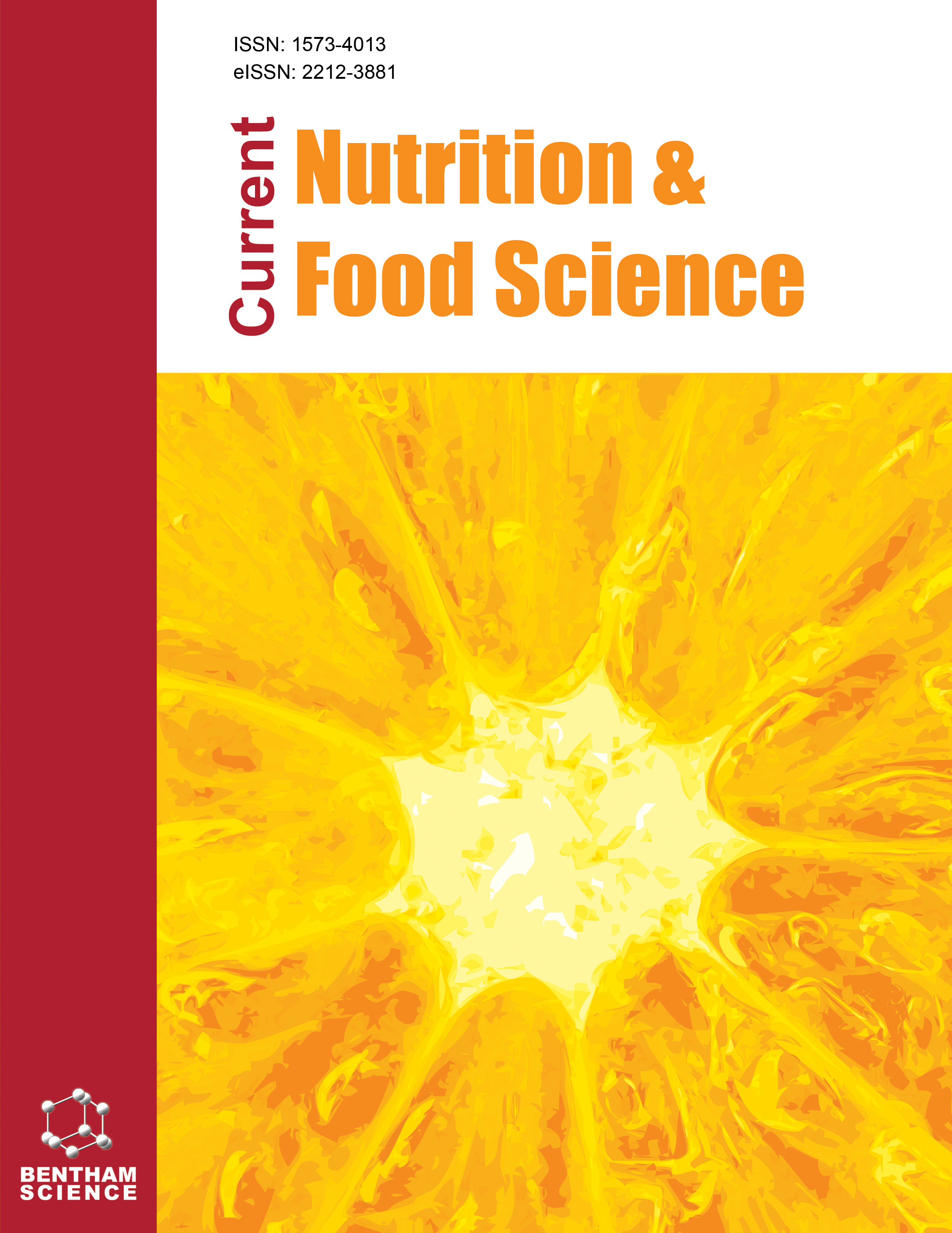- Home
- A-Z Publications
- Current Nutrition & Food Science
- Previous Issues
- Volume 18, Issue 9, 2022
Current Nutrition & Food Science - Volume 18, Issue 9, 2022
Volume 18, Issue 9, 2022
-
-
Automated Cultivation System for Microalgae: Growth Factors and Control
More LessAuthors: Jiun G. Khor, Hooi Ren Lim, Wen Yi Chia and Kit Wayne ChewBackground: Microalgae have been a hot research topic due to their various biorefinery applications, particularly microalgae as potential alternative nutraceuticals and supplements have a large and rapidly growing market. However, commercial production is limited due to high processing cost, low efficiency, and scale up of biomass production. Objective: It is important to control the microalgae cultivation syste Read More
-
-
-
Rapid and Precise Discrimination between Pure and Adulterated Commercial Indian Honey Brands using FTIR Spectroscopy and Principal Component Analysis
More LessAuthors: Bipin Singh and Sanmitra BarmanBackground: Four leading commercial Indian honey brands were investigated using FTIR spectroscopy and principal component analysis for rapid and accurate differentiation of pure, mildly adulterated, and highly adulterated honey brand samples. We examined the ability of PCA on second derivative of FTIR data to descriminate between the pure and adulterated commercial honey brands. Methods: This study is the first to i Read More
-
-
-
Could Polyphenolic Food Intake Help in the Control of Type 2 Diabetes? A Narrative Review of the Last Evidence
More LessAuthors: Luigi Ferrara, Marko Joksimovic and Stefania D'AngeloBackground: Diabetes is one of the most serious global public health concerns, imposing a significant burden on public health and socio-economic development, with type 2 diabetes accounting for 90 percent of individuals with the disease (T2D). Introduction: Beyond the hereditary factor, there are several risk factors associated with the development of this syndrome; the lifestyle plays an increasingly predominant role in the dev Read More
-
-
-
Effect of Medium on the Activity of Eugenol: A Mini-Review
More LessAuthors: Sameera A. Rege, Megha A. Varshneya and Shamim A. MominThe role of essential fatty acids is vital in the life of a human being. The lack of essential fatty acids causes various diseases, such as cardiovascular, inflammatory bowel, and obesity. Although synthetic antioxidants have already been used, nowadays, the demand for natural antioxidants has increased mainly because of the adverse effects of synthetic antioxidants. Spices are widely used in this context as a source of natural a Read More
-
-
-
Medicinal Importance, Pharmacological Activities, and Analytical Aspects of an Isoflavone Glycoside Tectoridin
More LessBackground: Polyphenols are a group of secondary plant metabolites produced in plants as a protective system against oxidative stress, UV radiation, pathogens, and predatorial attacks. Flavonoids are a major class of plant phenolics present in fruits, vegetables, tea, and red wine. Tectoridin, also called 40,5,7-thrihydroxy-6-methoxyisoflavone-7-Ob-D-glucopyranoside is an isoflavone glycoside present in the flower o Read More
-
-
-
Nutraceutical Approach to the Management of Cystic Fibrosis
More LessAuthors: Manali Chindarkar and Srujana MedithiBackground: Cystic fibrosis (CF) is an autosomal recessive monogenic disease marked by a mutation in the cystic fibrosis transmembrane conductance regulator gene. Cystic fibrosis transmembrane conductance regulator gene mutations affect respiratory, digestive and reproductive functions and impede bicarbonate, bile acid, and sweat secretion. Moreover, the current trend indicates that CF is no longer only a paed Read More
-
-
-
Contamination by Listeria monocytogenes in Latin American Meat Products and its Consequences
More LessAuthors: Natana Gengnagel and Alberto Gonçalves EvangelistaBackground: Listeria monocytogenes is one of the most important bacteria in food technology, causing listeriosis, a disease with high mortality rates, especially in developing countries. Objective: Thus, the objective of this review was to gather recent work on the presence of L. monocytogenes in meat and meat products in Latin America, in addition to pointing out control methods and resistance genes that can Read More
-
-
-
Vitamin D, Oxidative Stress and Glycaemic Control in Subjects with Type 2 Diabetes Mellitus: Systematic Review
More LessBackground: Diabetes mellitus (DM) is a metabolic and chronic disorder which causes high blood glucose concentrations and dysfunctional pancreatic beta-cells characterized by decreased insulin secretion and signalling. Scientific evidence suggests that vitamin D supplementation may help patients with type 2 diabetes mellitus (T2DM) improve glycaemic control, increase insulin secretion and decrease HbA1c concentrat Read More
-
-
-
Dietary Lifestyle of Clinical Nutrition Students Compared with That of Age-Matched Non-Medical Students
More LessAuthors: Noor A. Hakim, Demah A. Alwagdany, Jehan M. Hammad, Maram F. Kattan and Shahad A. MannanBackground: There is an assumption that clinical nutrition (CLN) students should have better nutrition and health statuses and practice healthier lifestyles than other students. However, the effect of pursuing nutritional studies on student dietary lifestyle is not well known. Objective: To investigate differences in nutritional status between CLN-major and Administration/ Humanities-major (AHM) students as well as determi Read More
-
Volumes & issues
-
Volume 21 (2025)
-
Volume 20 (2024)
-
Volume 19 (2023)
-
Volume 18 (2022)
-
Volume 17 (2021)
-
Volume 16 (2020)
-
Volume 15 (2019)
-
Volume 14 (2018)
-
Volume 13 (2017)
-
Volume 12 (2016)
-
Volume 11 (2015)
-
Volume 10 (2014)
-
Volume 9 (2013)
-
Volume 8 (2012)
-
Volume 7 (2011)
-
Volume 6 (2010)
-
Volume 5 (2009)
-
Volume 4 (2008)
-
Volume 3 (2007)
-
Volume 2 (2006)
-
Volume 1 (2005)
Most Read This Month
Article
content/journals/cnf
Journal
10
5
false
en


